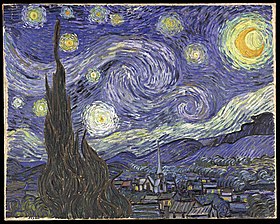Lucien (Mirbeau)
| Lucien | |
|---|---|
| First appearance | Dans le ciel (In the sky) (1892-1893) |
| Created by | Octave Mirbeau |
| In-universe information | |
| Species | Human |
| Gender | Male |
| Occupation | Painter |
| Nationality | French |

Lucien is one of the central fictional characters in the 1892-93 novel Dans le ciel (In the Sky), by French writer Octave Mirbeau.
The tragedy of an artist
He is the friend of the embedded narrator, Georges, to whom he has bequeathed his house, situated on a fantastic mountain peak that rises vertiginously into the sky. Lucien is modeled on

Like
But Lucien's conception of art remains confused, as he moves back and forth between
In creating a character who constantly challenges himself, who constantly aspires to an absolute that is impossible and unattainable, Mirbeau explores the tragedy of an artist who is uncompromising, unwilling to conform to the academic traditions of art, and who, rather than submitting to them, confronts head-on the institutionalized prejudices encountered in the world of politics, the fine arts, and a public inhospitable to change.[4]
References
- ^ Octave Mirbeau, « Vincent Van Gogh », L'Écho de Paris, 1891/03/31.
- ^ Octave Mirbeau, L'Abbé Jules, Éditions du Boucher, 2003.
- ^ Octave Mirbeau, Combats esthétiques, Nouvelles éditions Séguier, 2 vol., 1993.
- ^ See Christian Limousin,« La Critique d'art de Mirbeau : de “l'âge de l'huile diluvienne” au règne de l'artiste de génie » Archived 2006-11-28 at the Wayback Machine, Cahiers Octave Mirbeau, n° 1, 1994, 11-41.
Bibliography
- Samuel Lair, « Octave Mirbeau et le personnage du peintre », Cahiers d'études du récit français, n° XX, Université de Brest, 2004, p. 119-129.
- Maeva Monta, « Dans le ciel, un détournement de la figure de l'ekphrasis », Cahiers Octave Mirbeau, n° 18, 2011, p. 35-49.
- Robert Ziegler, « The Uncreated Artwork in Mirbeau's Dans le ciel », Nineteenth-Century French Studies , winter 2007, vol. 35, n° 2, p. 439-452.
External links
- Pierre Michel, « Dans le ciel, ou la tragédie de l'artiste », Foreword, Dans le ciel, Éditions du Boucher, 2003.
- Claire Nettleton, « The Animal and Aesthetic Nihilism in Octave Mirbeau's Dans le ciel », in Primal Perception : The Artist as Animal in Nineteenth-Century France], Université de Californie du Sud, 2010, p. 154-202.
- Laurence Tartreau-Zeller, « Van Gogh, l'idéal de Mirbeau », Cahiers Octave Mirbeau, n° 1, 1994, p. 56-80.
- Robert Ziegler, « The art of verbalizing the barking of a dog : Mirbeau's Dans le ciel », 2005.
